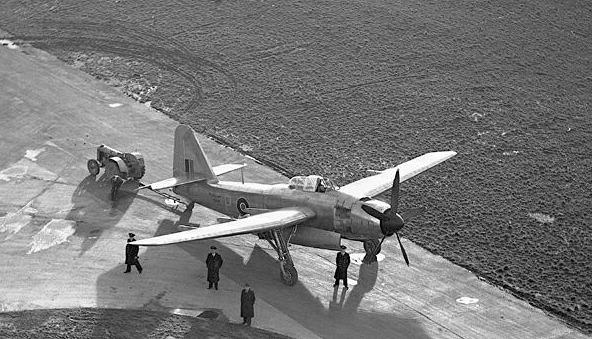- Yes
- No
Fairey Spearfish TB Mk.1

Design and history
The Fairey Spearfish was a British carrier-based torpedo and dive bomber, that was ordered by the FAA during the second world war. The design process started during the war, but the first prototype didn’t fly until July of 1945, making it just one of many British aircraft to miss the war. The Spearfish was significantly larger than earlier British naval bomber’s and was more inline with American designs of the time, as it was intended to operate from the unbuilt Malta-class aircraft carriers, which like the Spearfish, would be cancelled in the immediate post-war period.
The Spearfish was designed by Fairey Aviation, who worked on the majority of the FAA aircraft of the period, to Spec 0.5/43, which called for a replacement to the Barracuda, also from Fairey. The design requirements resulted in a more powerful aircraft, with a larger engine, internal weapons bay and a retractable ASV Mk.XV surface-search radar, which was mounted behind the bomb bay. The resulting aircraft was 50% larger than the preceding Barracuda, and took the form of a cantilever, mid-wing monoplane of all-metal design. The wing section was build as part of the main fuselage, increasing strength, and the wings like most FAA planes, could be folded for carrier operations. The wings possessed a large flap system that spanned nearly 75% of the wings’ trailing edge, resulting in the protruding structures on the aft side of the wings. For fuel the Spearfish carried a pair of 183-imperial-gallon (830 L; 220 US gal) fuel tanks, plus a 43-imperial-gallon (200 L; 52 US gal) tank in the leading edge of the starboard wing for a total of 409 imperial gallons (1,860 L; 491 US gal) of fuel giving it an range of just over 900 nautical miles allowing it to strike targets at respectable range along with good loiter times for ASW duties. In terms of crew, the Spearfish possessed a two-man tandem cockpit, with pilot and tailgunner positions.
The Spearfish was in possession of a large internal weapons back, which could carry a wide range of ordnance. Common options housed in this internal bay were up to four 500-pound (230 kg) bombs, four equivalent weight depth charges, one torpedo, or an additional aux fuel tank. This was supplemented by wing racks, which could carry 16 RP-3 rockets, and four 0.5-inch (12.7 mm) M2 Browning machine guns, the first two mounted forward in the wing for suppression strafing, and two mounted in a dorsal Fraser-Nash FN 95 barbette behind the cockpit.
With the design in place a production order for 150 aircraft was placed, with the first ten aircraft intended to use 2,600-horsepower (1,900 kW) Bristol Centaurus radial engines, Centaurus 59 engines on the next 22, and Centaurus 60s for the last 118. This was not to be, though, as with the cancellation of the the Malta class, the FAA had no requirement for the new torpedo bomber, and the Spearfish was part of the post-war culling of the British war manufacturing contracts. This wouldn’t mark the end of the Spearfish though, as due to its large size the airframe proved ideal for testing, with the first prototype being used by Napier & Son at Luton for trials of the firm’s inflight de-icing systems. This same aircraft would later be used for ground training purposes before being scrapped in 1952. The other prototypes did not have as long a life, the second was scrapped soon after testing, the third was damaged during a heavy landing during testing of the ASV Mk.XV radar and scrapped in 1950, and the fourth was cannibalised for spares for the other 3 prototypes. The final aircraft was used for engine cooling and power assisted flying control trials, but was ultimately scrapped in 1951, marking the end of the type. In total 7 prototypes were ordered, 5 were built, 4 or which actually flew, and instead of being the next glorious stage of British naval aviation, they were a side note for experimental work before the last airframe was scrapped in 1952.
Plane specification:


General characteristics
Crew: two
Length: 44 ft 7 in (13.59 m)
Wingspan: 60 ft 3 in (18.36 m)
Height: 13 ft 6 in (4.11 m)
Empty weight: 15,200 lb (6,895 kg)
Gross weight: 21,642 lb (9,817 kg)
Max takeoff weight: 22,083 lb (10,017 kg)
Fuel capacity: 409 imperial gallons (1,860 L; 491 US gal)
Powerplant: 1 × Bristol Centaurus 57 18-cylinder radial engine, 2,825 hp (2,107 kW)
Propellers: 5-bladed Rotol VH 65, 14 ft (4.3 m) diameter
Performance
Maximum speed: 298 mph (480 km/h, 259 kn)
Cruise speed: 196 mph (315 km/h, 170 kn)
Range: 1,036 mi (1,667 km, 900 nmi)
Combat range: 349 mi (562 km, 303 nmi)
Service ceiling: 25,000 ft (7,600 m)
Time to altitude: 7.75 minutes to 10,000 feet (3,000 m)
Armament
Guns: 4 × .50 in (12.7 mm) M2 Browning machine guns, two in the wings and two in a Frazer-Nash FN95 remote-controlled dorsal barbette
Rockets: 16 × RP-3 rocket projectiles on underwing rails
Bombs: carried in an internal weapons bay; either:
1 × torpedo or
2,000 lb (907 kg) of bombs or depth charges
Additional Photos:








Sources:
- Fairey Spearfish; The (Obsolete) British Avenger - Forgotten Aircraft - Military Matters (history)
- Fairey Spearfish - Wikipedia. (Wiki for the type)
- Fairey Spearfish (more history)
- Fairey Spearfish - torpedo bomber (Additional specs)
- Fairey Spearfish Torpedo / Dive Bomber Aircraft Prototype (More history)
- Fairey Spearfish | Secret Projects Forum (Source of some images)